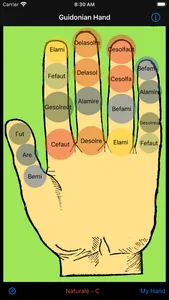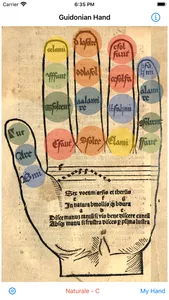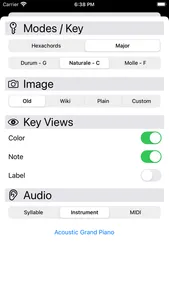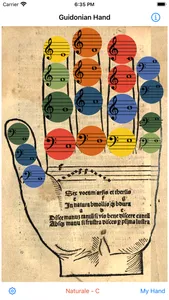In Medieval music, the Guidonian hand was a mnemonic device used to assist singers in learning to sight-sing. With this app you can learn how it was used and have some fun making music.
This app turns images of the Guidonian hand into a keyboard which you can play. Each joint and tip of a finger is a key which plays an instrument tone, a solmization syllable or a MIDI pitch. The keys can be visualised in different ways. You can also play on photos of real hands thanks to hand recognition.
Guido of Arezzo or Guido d'Arezzo (c. 991–992 – after 1033) was an Italian music theorist and pedagogue of High medieval music. Guido developed new techniques for teaching, such as staff notation and the use of the "ut–re–mi–fa–sol–la" (do–re–mi–fa–so–la) mnemonic (solmization).
The idea of the Guidonian hand is that each portion of the hand represents a specific note within the hexachord system, which spans nearly three octaves from "Γ ut" (that is, "Gamma ut") (the contraction of which is "Gamut", which can refer to the entire span) to "E la" (in other words, from the G at the bottom of the modern bass clef to the E at the top of the treble clef).
In teaching, an instructor would indicate a series of notes by pointing to them on their hand, and the students would sing them. The notes of the gamut were mentally superimposed onto the joints and tips of the fingers of the left hand.
This app turns images of the Guidonian hand into a keyboard which you can play. Each joint and tip of a finger is a key which plays an instrument tone, a solmization syllable or a MIDI pitch. The keys can be visualised in different ways. You can also play on photos of real hands thanks to hand recognition.
Guido of Arezzo or Guido d'Arezzo (c. 991–992 – after 1033) was an Italian music theorist and pedagogue of High medieval music. Guido developed new techniques for teaching, such as staff notation and the use of the "ut–re–mi–fa–sol–la" (do–re–mi–fa–so–la) mnemonic (solmization).
The idea of the Guidonian hand is that each portion of the hand represents a specific note within the hexachord system, which spans nearly three octaves from "Γ ut" (that is, "Gamma ut") (the contraction of which is "Gamut", which can refer to the entire span) to "E la" (in other words, from the G at the bottom of the modern bass clef to the E at the top of the treble clef).
In teaching, an instructor would indicate a series of notes by pointing to them on their hand, and the students would sing them. The notes of the gamut were mentally superimposed onto the joints and tips of the fingers of the left hand.
Show More




